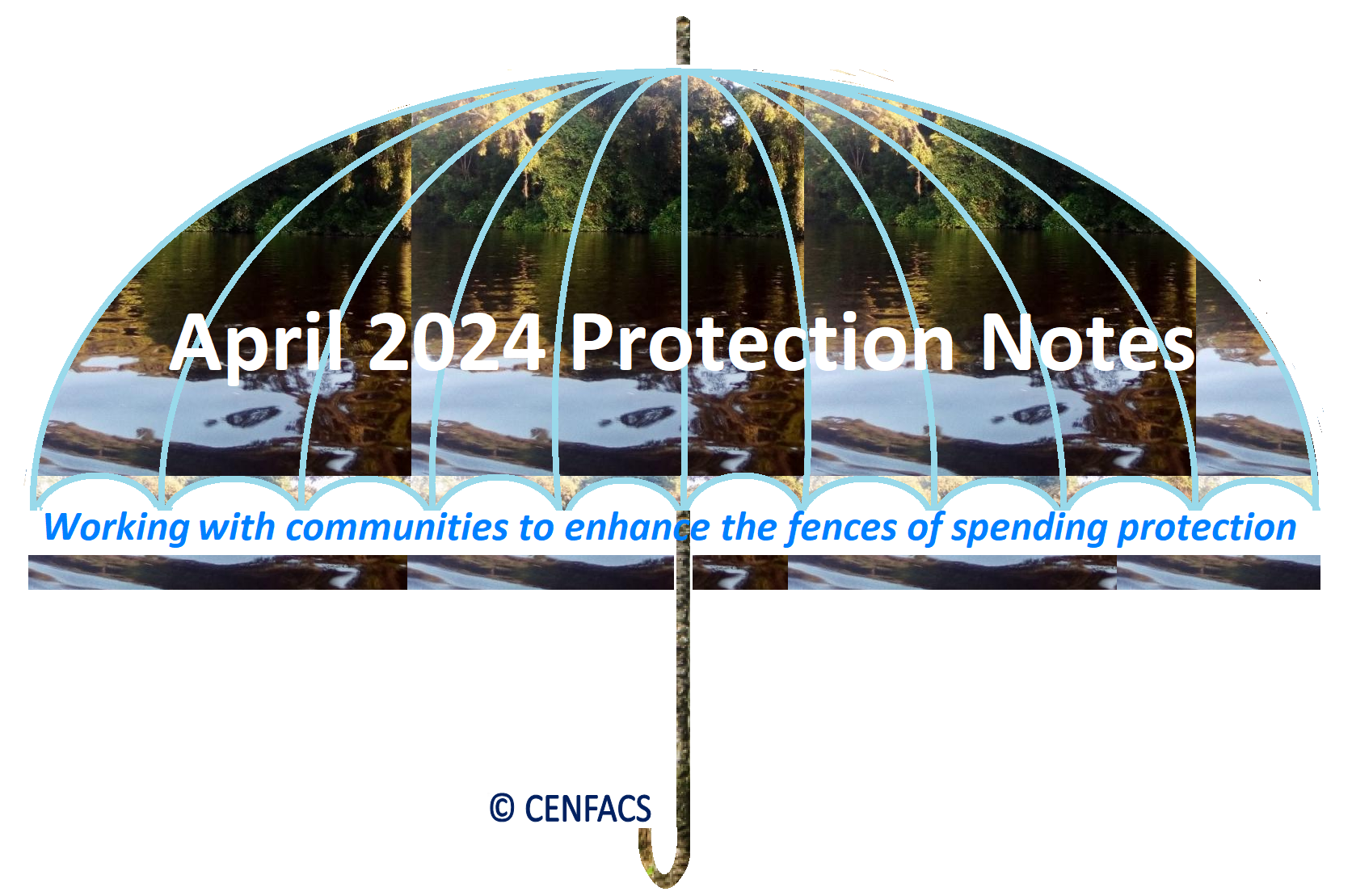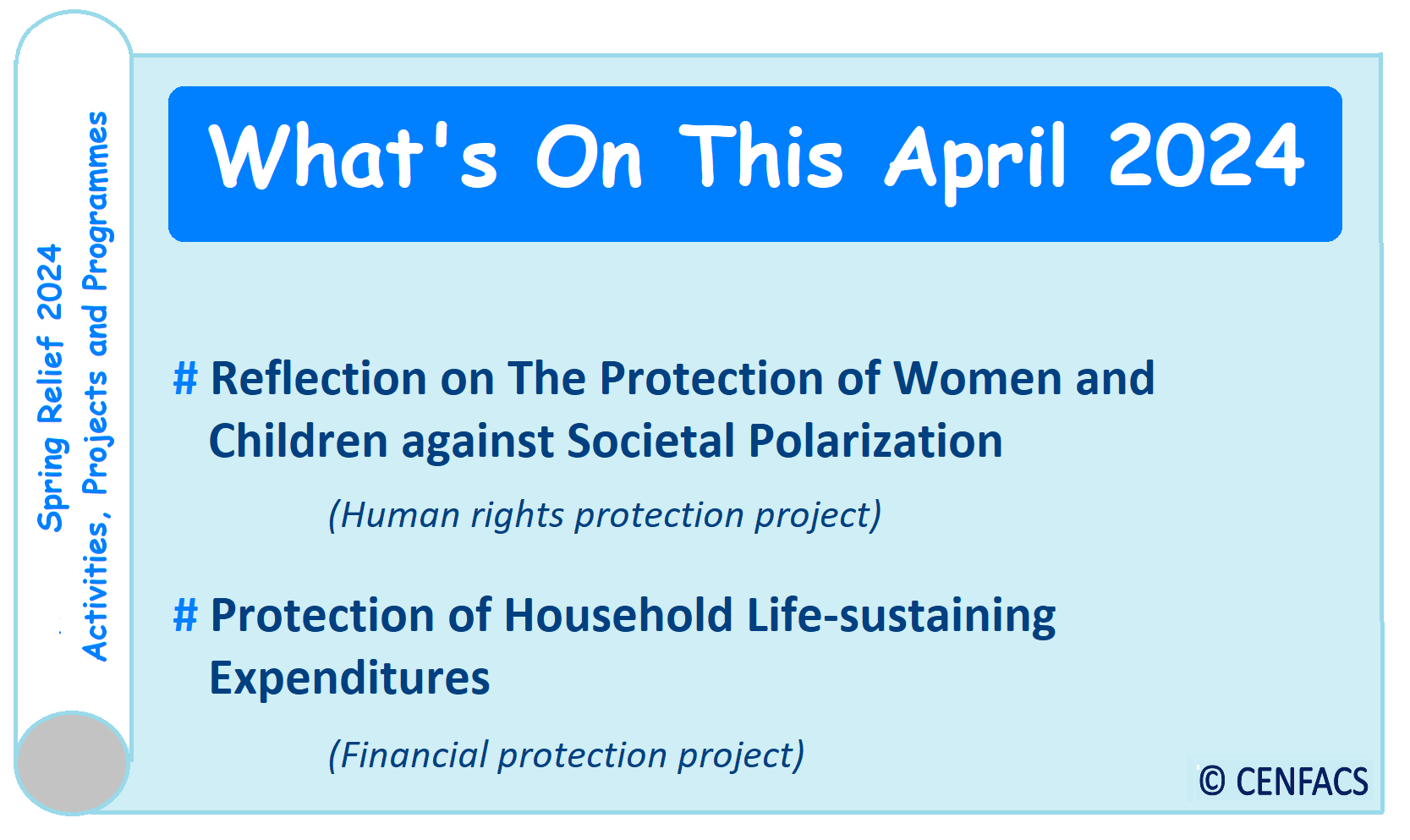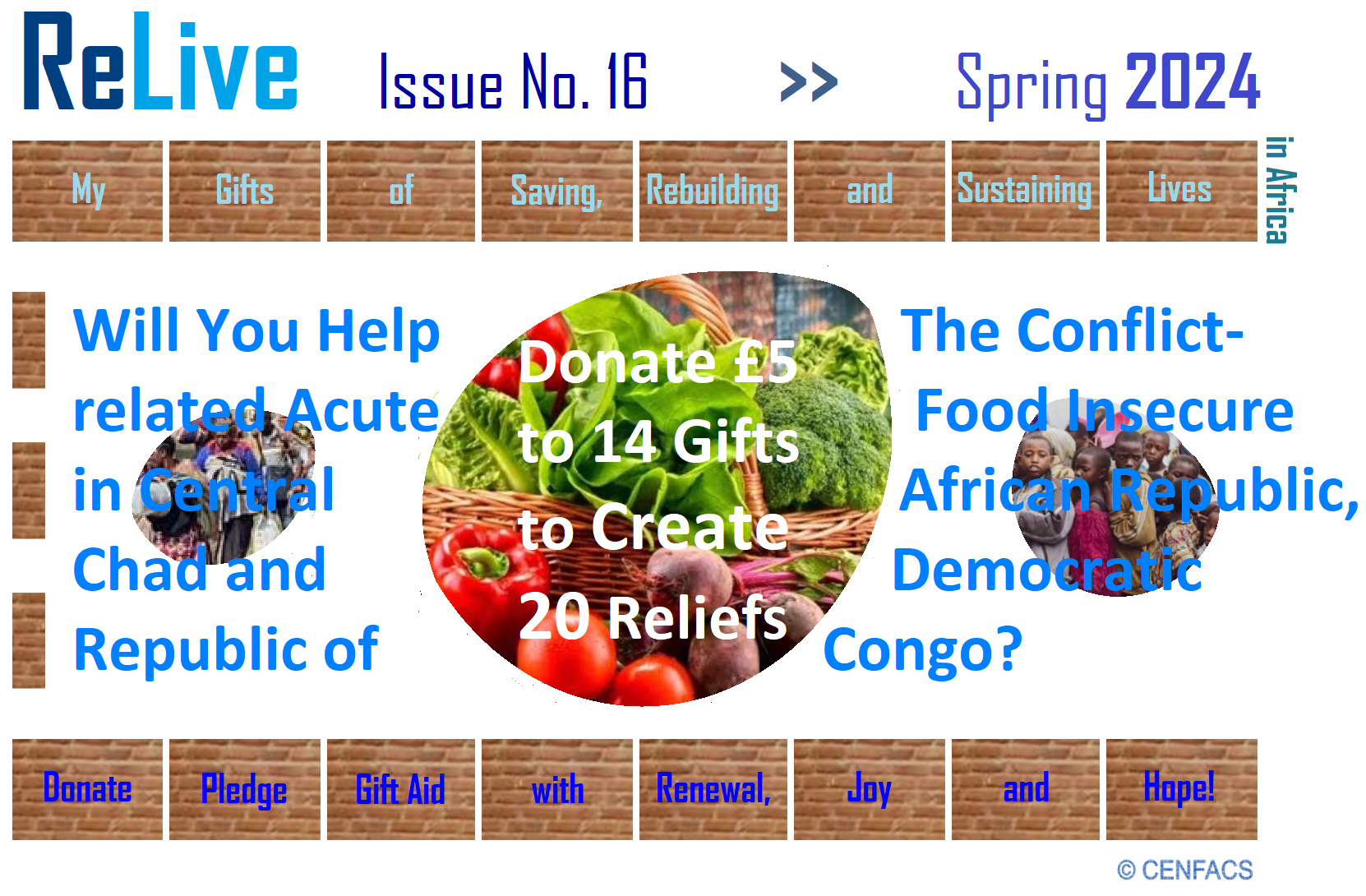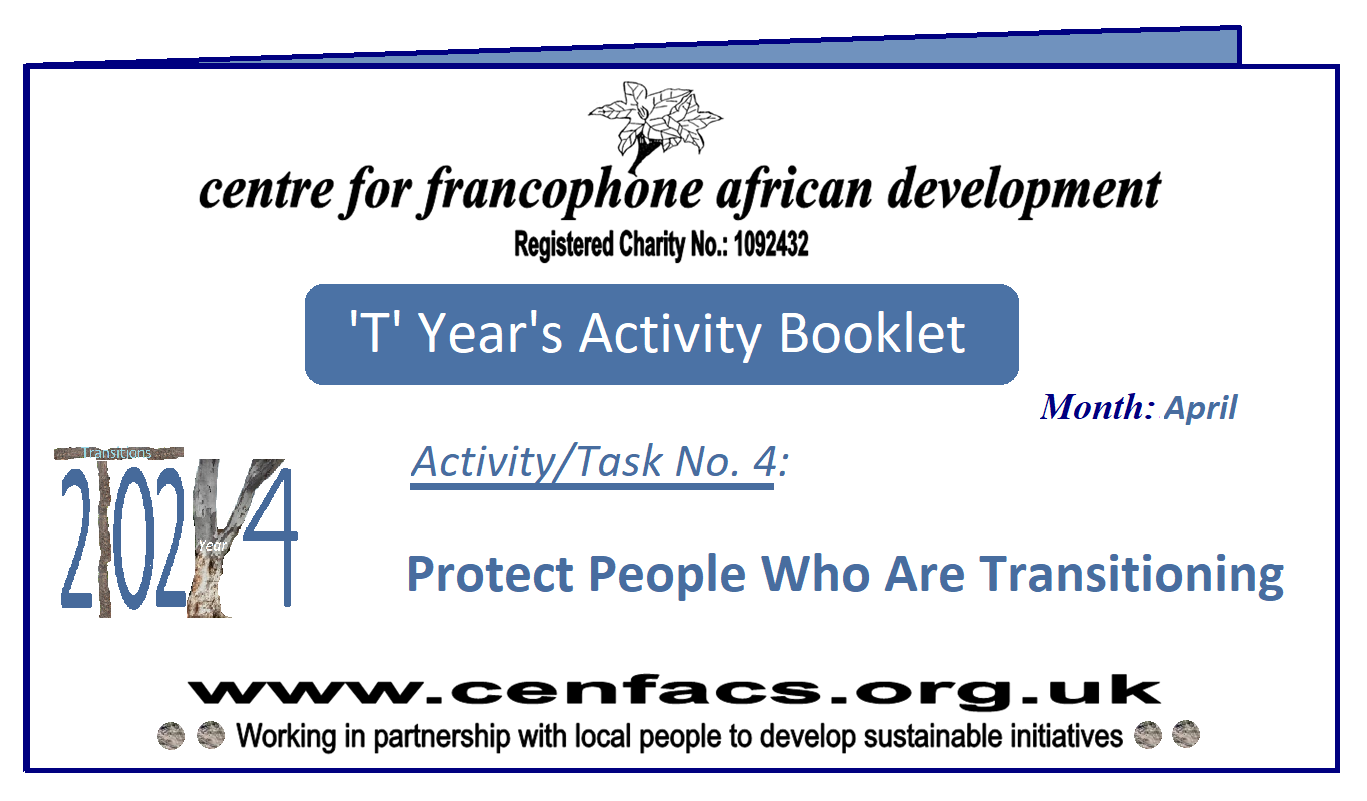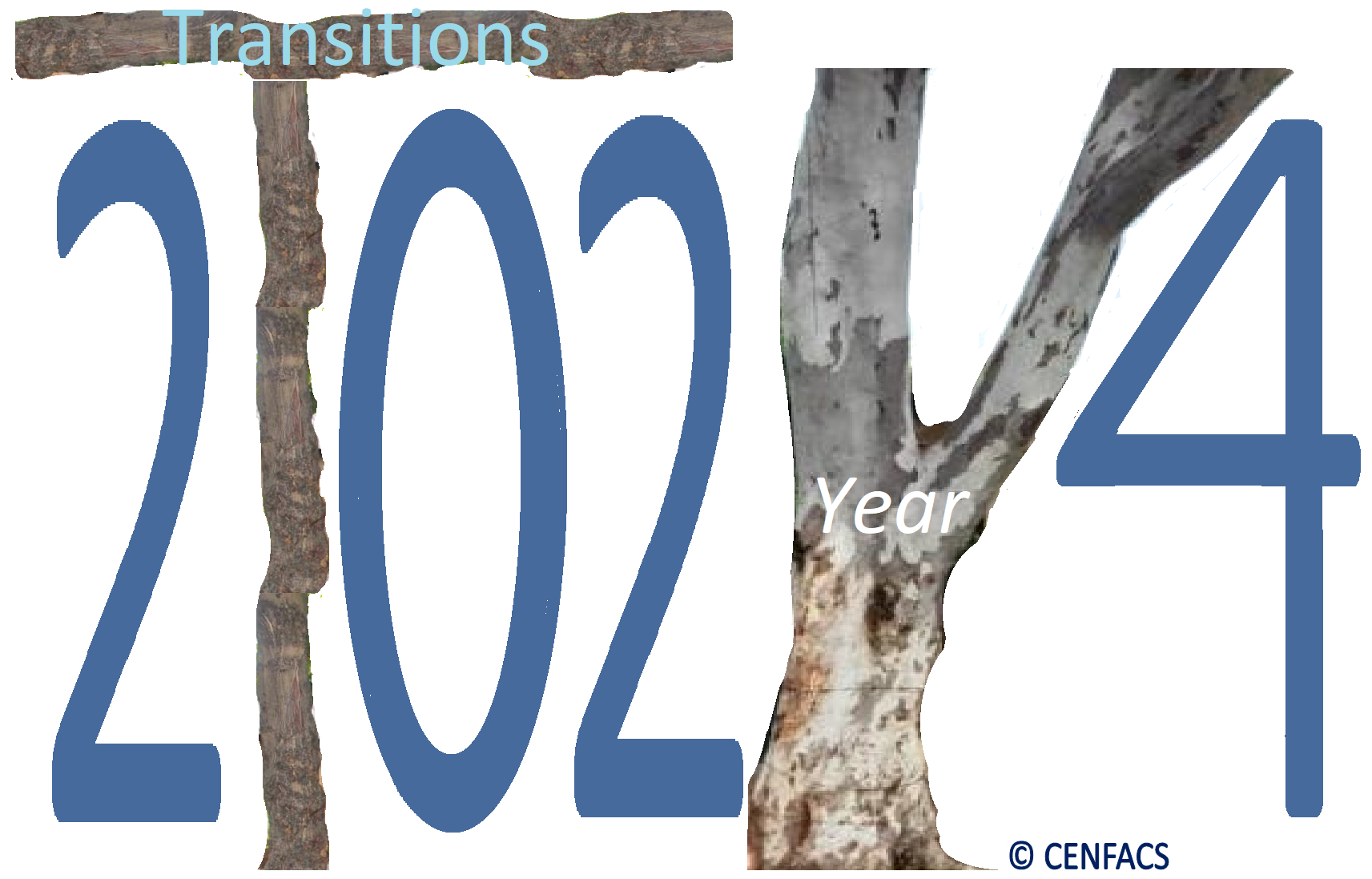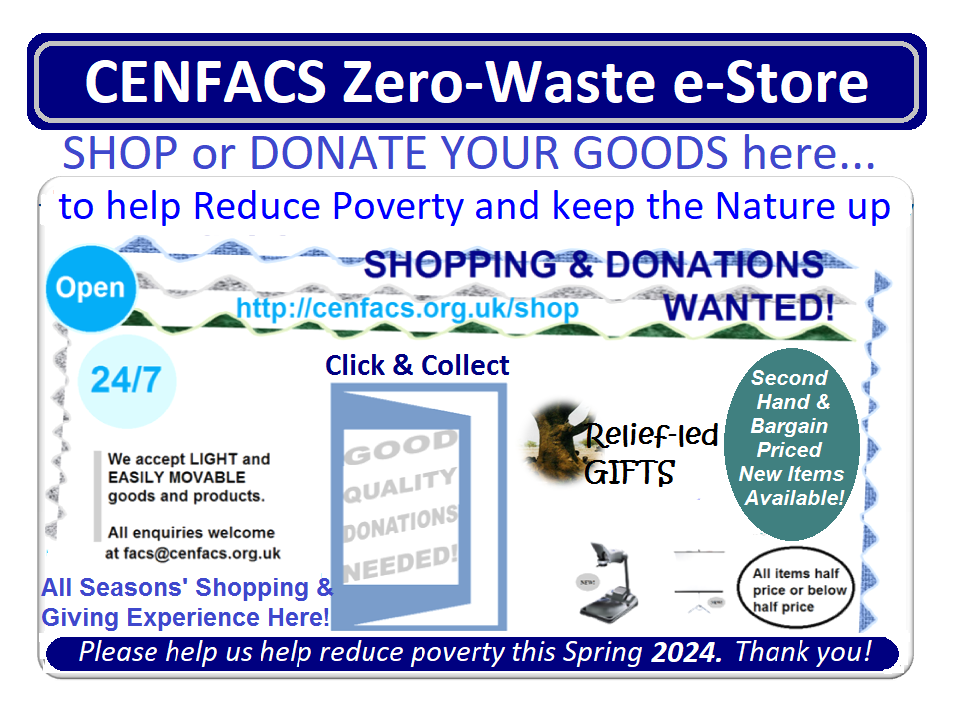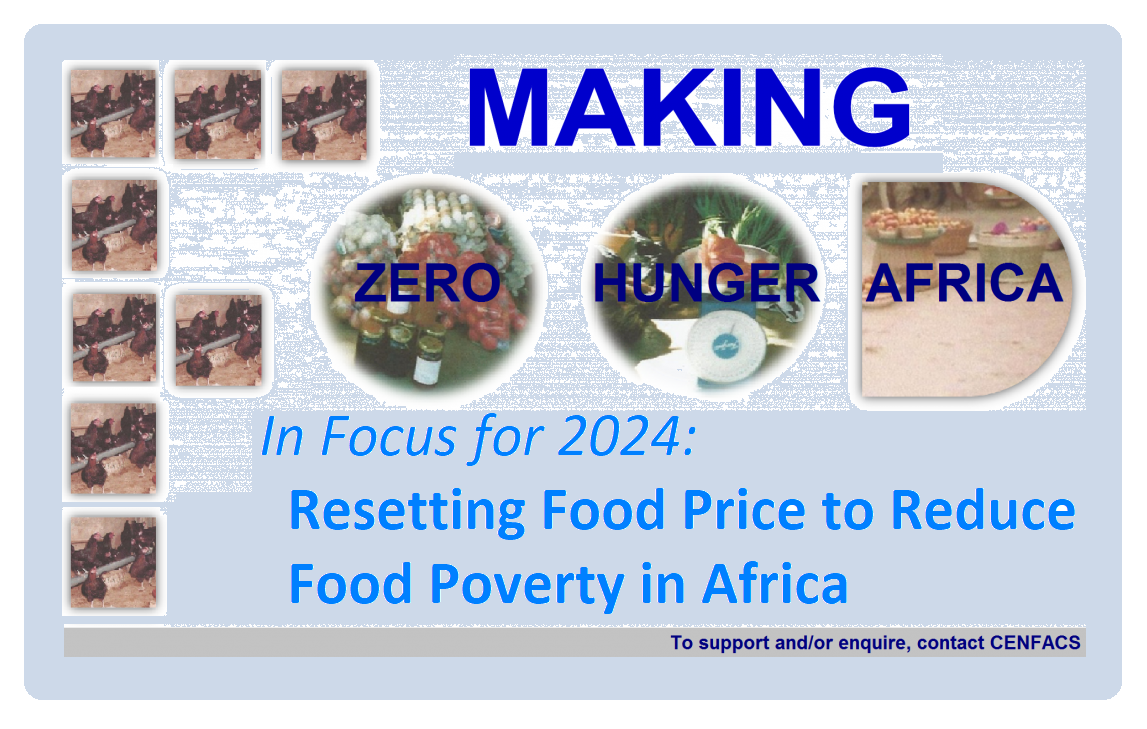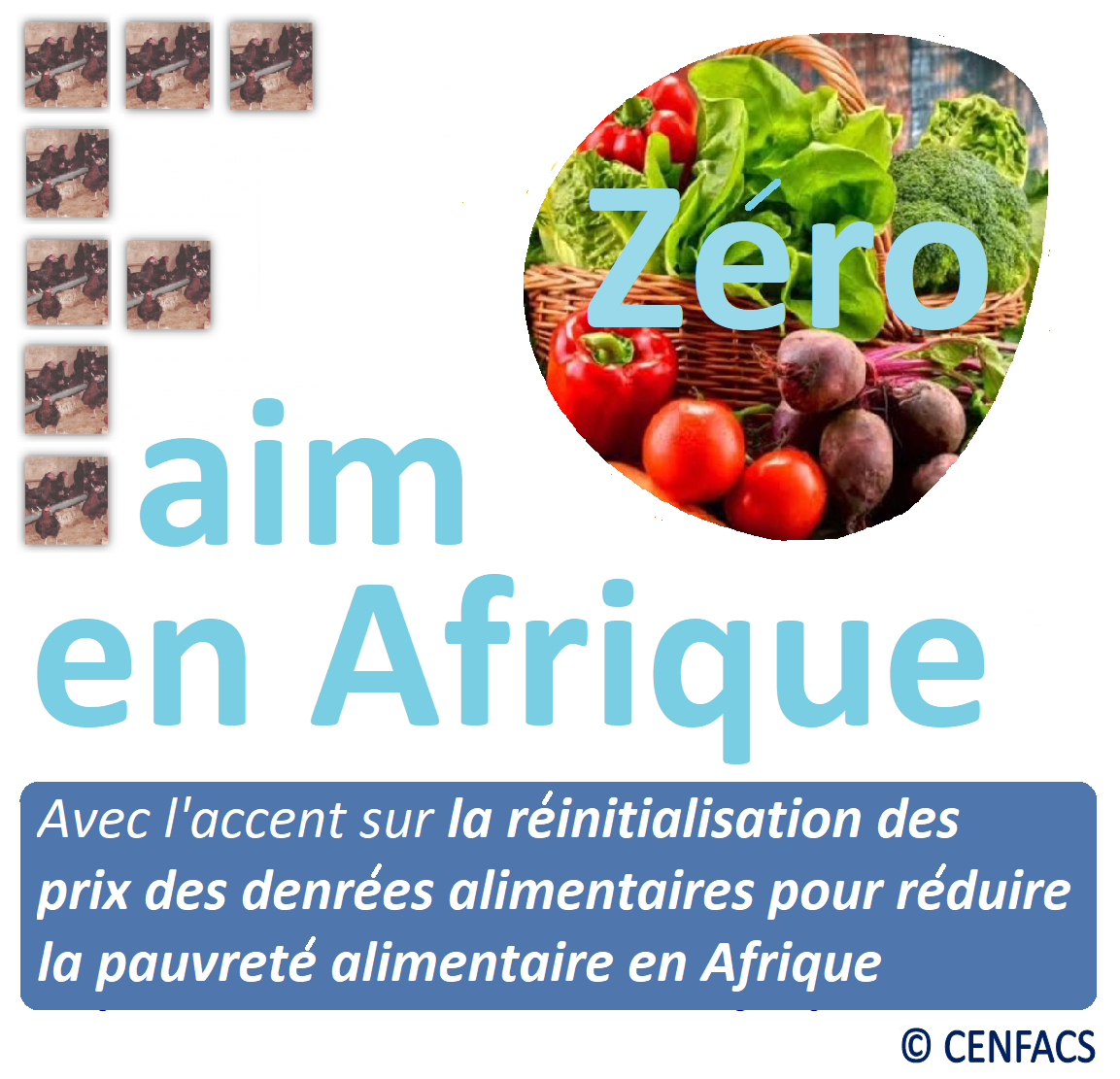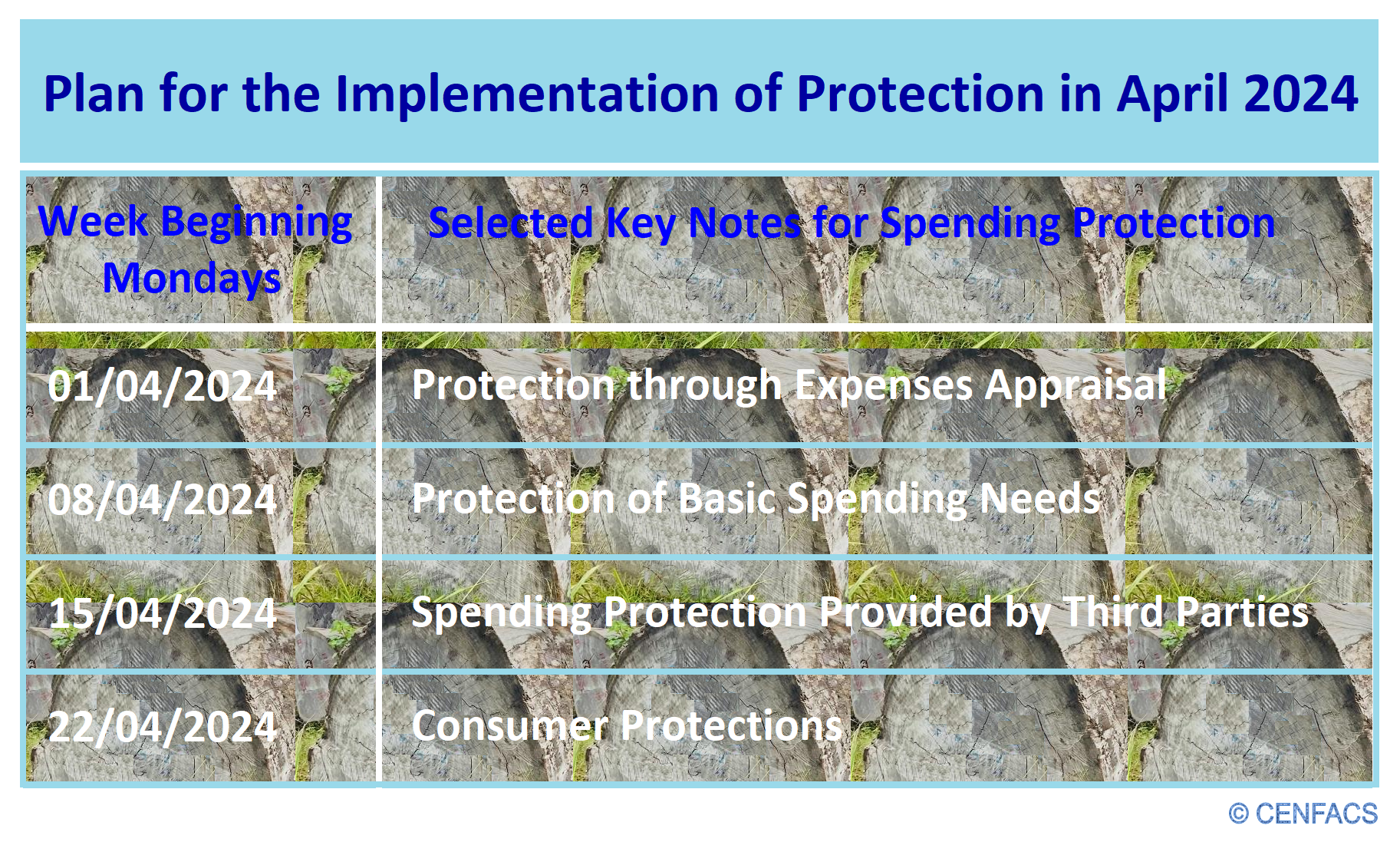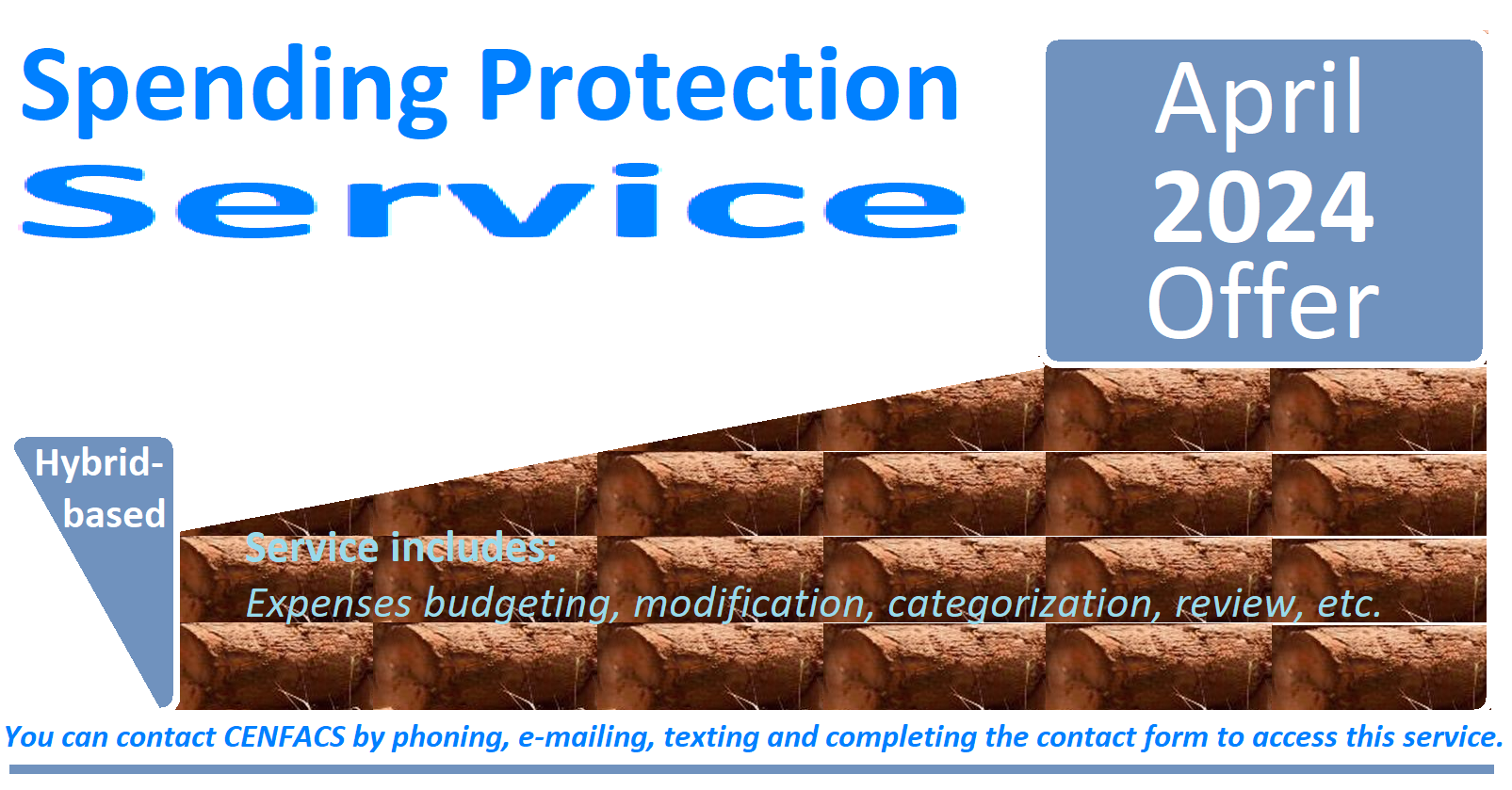Welcome to CENFACS’ Online Diary!
03 April 2024
Post No. 346
The Week’s Contents
• Protection in The Context of Squeezed Household Spending
• ReLive Issue No. 16, Spring 2024: Will You Help The Conflict-related Acute Food Insecure in Africa to Rebuild and Renew Their Lives?
• Activity/Task 4 of the ‘t’ Project: Protect People Who Are Transitioning
… And much more!
Key Messages
• Protection in The Context of Squeezed Household Spending
This Spring 2024, our Protection work will be conducted within the context of Squeezed Household Spending. It is the context in which low income households are trying to shield themselves from spikes in prices of goods and services. These spikes have led to the squeeze of household final consumption expenditures, including household accounts of our community members. Yet, everybody has to spend on a minimum of life necessities in order to keep their life running without collapsing as humans.
Indeed, there has been a squeeze on household spending and living standards. For example, according to the Office for National Statistics (1) in the UK,
“From Quarter 4 (Oct. to Dec.) 2021 to Quarter 2 (Apr. to June) 2023, there has been a fall in the quantity and/or quality of many items bought by households, but increasing prices mean that the overall nominal value of household spending has risen sharply”.
The Office for National Statistics (2) in the UK also argues that
“In Quarter 3 (July to Sept.) 2023, household spending growth (adjusted for inflation) was negative 0.5%, compared with Quarter 2 (Apr. to June) 2023”.
Decrease in household spending can be an indication of the struggle that households are having to make ends meet. Easing the squeeze can help decrease the difficulty these households are experiencing.
Squeeze on household spending requires protection. This month, we are going to explore the available options to protect basic expenditures. In other words, we are going to work on the types of protection that can help to cover people’s needs rather than people’s wants.
When people speak about expenses or spending or expenditures, often the verb they use is cut or reduce or trim or cancel them. They also employ the term ‘spending review’; meaning in-depth assessment of expenditure and identification of opportunities to improve efficiency and to redirect spending. But, there are expenses or spending or expenditures that are uncuttable, like those relating to basic necessities. People living below or on poverty line cannot have them cut. If cutting basic expenses or spending or expenditures is not what one should be aiming at for protection, then one should look at other ways of protecting the expenses/spending/expenditures of those in need.
Throughout the month of April 2024, we are going to try to go beyond generic or classic recipes of protecting expenses/spending/expenditures to explore new and innovative ways of approaching their protection for the poor; ways that reflect the kinds of context or circumstances we have today and will be having tomorrow. Today, we are in the context of skyrocketing prices and bills at a rate and pace that no expenses/spending/expenditures plan of poor household can match or follow. Tomorrow, there could be different types of challenges or crises with damaging effects on poor household expenditure. Yet, these poor people need a certain level of expenses/spending/expenditures to live on as humans.
Both generic or classical solutions and new approaches to protecting expenses/spending/expenditures of the poor are highlighted in our April 2024 action plan to work with poor households with squeezed expenditure problems to protect their minimal expenses/spending/expenditures. To find more about this action plan and what is likely to be the Month of Protection within CENFACS, please read under the Main Development section of this post.
• ReLive Issue No. 16, Spring 2024: Will You Help The Conflict-related Acute Food Insecure in Africa to Rebuild and Renew Their Lives?
• • What is ReLive?
ReLive is one of CENFACS’ Spring campaigns and a bridge between CENFACS’ Winter Lights and Spring Relief seasons.
As ReLive advocacy is designed to plead for help to the peoples and communities whose lives and livelihoods have been destroyed to rebuild themselves. The current appeal will try to achieve this for the Central African Republic, Chad and the Democratic Republic of Congo this Spring 2024.
Although this appeal is a seasonal appeal related to Spring, it is also a consolidated one following our Winter Light appeals.
• • What Is the Focus for ReLive in 2024?
The 16th issue of CENFACS’ Once-a-year Spring Appeal for Renewing Lives (ReLive) will focus on advocating for the support of the food insecure people, particularly those who are and have been the victims of conflict or wars in Africa. For the purpose of this year’s Spring Renewing Life Appeal, we are going to limit to three countries: Central African Republic, Chad and Democratic Republic of Congo.
Because of the similarities and patterns of conflict events and humanitarian issues in these countries, we have launched a unified appeal to cater for the three countries. We are doing it through what we call Gifts of Renewing Lives or Life-Renewing Projects. The underlying principle of ReLive campaign is to help rebuild or renew lives rather than to respond to emergency and contingency needs.
From 2020 to 2023, we went out of our way to respond to shocks and crises (like the coronavirus, the cost-of-living crisis and geo-economic crisis brought by the Russia-Ukraine conflict). During that time, our ReLive Campaign dealt more with crises and shocks than the principle of rebuilding and renewing lives.
Now, we are resetting our system of poverty reduction, we are returning our ReLive Campaign to its original format of rebuilding and renewing lives over Spring. Like before, we are going to do it through Gifts of Renewing Lives or Life-renewing Projects.
• • What Are Gifts of Renewing Lives or Life-renewing Projects (LRPS)?
Life-renewing projects (LRPs) are poverty relief and Spring like gifts designed to materialise ReLive advocacy by helping people to set free from multi-dimensional deprivations and hardships so that they can start up again, renew and rebuild their lives with hope.
LRPs are part of CENFACS’ African Rebuilding and Sustaining Infrastructures and Lives Programme. Spring Gifts of Renewing Lives are about bringing renewal, joy and hope to needy people. These Spring 2024 Gifts will be about bringing the same benefits to the peoples of these three selected African countries.
• • What Are These Ways or Gifts of Renewing Lives?
This Spring, we are running 14 Gifts in a world of 20 Reliefs or Helpful Differences. What does this mean?
It means donors or funders have 14 Gifts of Renewing Lives to choose from and 20 Reliefs to select from to make helpful differences to the food insecure.
In total, our Spring Relief campaign is providing to potential supporters 14 GIFTS of rebuilding lives in the three African Countries in 20 RELIEFS to make this happen.
For this renewal to happen, support is needed towards LRPs.
To support, go to http://cenfacs.org.uk/supporting-us/
• Activity/Task 4 of the ‘t’ Project: Protect People Who Are Transitioning
• • What Activity/Task 4 of the ‘t’ Project Is about
The third activity/task of the “t” Project is about what we can do to support or protect those around us and in our community who are experiencing transition.
Transition, whether it is climate or economic or educational or professional transition or other can be challenging and sometimes difficult to bear, especially for the most vulnerable and fragile members of our community/organisation.
• • Supporting or Protecting Those Who Are Transitioning
In their process of transition, these vulnerable and fragile peoples may need support or protection to cope with what they are going through. They need to be shielded as they are passing from one situation to another, which could be difficult one. They need understanding and company as they are experiencing changes in their life.
• • Example of Support or Protection
For example, those who are experiencing financial hardship while transitioning will need protection. In the UK, the Benefits Agency provides to benefit claimants Universal Credit transitional protection (3), which is an extra transitional amount which tops up your Universal Credit award so that you are not substantially worse off when you move onto Universal Credit.
What proceeds is just an example of ways of protecting transition and those who are transitioning. We are not asking everybody to do the same like Benefits Agency does. What could be good is that depending on one’s capacity and ability, they can decide themselves what they can do to support or protect those who are vulnerable and undergoing transition to succeed in their transitioning process.
The above is what activity/task 4 is about. For those who need any help before embarking on this activity/task, they can speak to CENFACS.
For any other queries and enquiries about the ‘t‘ project and this year’s dedication, please contact CENFACS as well.
Extra Messages
• Shop at CENFACS’ Zero Waste e-Store during This Spring Giving Season
• All-year Round Projects Cycle (Triple Value Initiatives Cycle) – Step/Workshop 7: Implementing Your Play, Run and Vote Projects
• Making Zero Hunger Africa Campaign with a Focus on Resetting Food Price to Reduce Food Poverty in Africa
• Shop at CENFACS’ Zero Waste e-Store during This Spring Giving Season
CENFACS e-Store is opened for your Spring goods donations and goods purchases.
At this time, many household expenditures have been squeezed by the cost of living pressures mostly driven by the hikes in prices of basic life-sustaining needs (e.g., food, transport, housing, council tax, phone, etc.). This is despite the fact that inflation is now low (almost between 3% and 4%) compared to last Spring’s figure (around 8.7%) , and the reduction of energy price.
The impacted of the cost of living pressures needs help and support as prices and bills are still higher while real incomes are less for many of those living in poverty.
Every season or every month is an opportunity to do something against poverty and hardships. This April too is a good and great month of the year to do it.
You can donate or recycle your unwanted and unneeded goods to CENFACS’ Charity e-Store, the zero waste shop built to help relieve poverty and hardships.
You can as well buy second hand goods and bargain priced new items and much more.
CENFACS’ Charity e-Store needs your support for SHOPPING and GOODS DONATIONS.
You can do something different this Season of Goods Donations by SHOPPING or DONATING GOODS at CENFACS Charity e-Store.
You can DONATE or SHOP or do both:
√ DONATE unwanted Easter GOODS, GIFTS and PRODUCTS to CENFACS Zero Waste e-Store this April and Spring.
√ SHOP at CENFACS Zero Waste e-Store to support noble and beautiful causes of poverty relief this April and Spring.
Your SHOPPING and or GOODS DONATIONS will help to the Upkeep of the Nature and to reduce poverty and hardships brought by the cost of living pressures.
This is what the Season of Giving is all about.
Please do not hesitate to donate goods or purchase what is available at CENFACS Zero Waste e-Store.
Many lives have been threatened and destroyed by the cost of living pressures.
We need help to help them come out poverty and hardships caused by these pressures.
To donate or purchase goods, please go to: http://cenfacs.org.uk/shop/
• All-year Round Projects Cycle (Triple Value Initiatives Cycle) –
Step/Workshop 7: Implementing Your Play, Run and Vote Projects
After making the organisational structure of your chosen Play, Run and Vote Projects, it is now the time to proceed with the Implementation Step.
• • What Is an Implementation Step?
There are many definitions within the literature about project implementation. One of them comes from ‘taskmanagementguide.com’ (4) which states that
“Project implementation is a practice of executing or carrying out a project under a certain plan in order to complete this project and produce desired results”.
The above definition indicates that one needs an implementation plan. As an all-year-round project implementor, you can draw up your implementation plan that shows the way you would like to execute and carry out your project.
Having said that Project Implementation is the step you put your project plan into action. You want your all-year-round project to fulfil and accomplish the goals and objectives you have set up for it. It is also the phase during which you can register, review and approve/reject any changes and variations. As an all-year-round project manager of your project, you need to coordinate all project aspects and resources to meet the objectives of the project plan. One of the aspects of the project implementation is change control.
• • What Is Change Control in a Project implementation Process?
The website ‘ecampusontario.pressbooks.pub’ (5) states that
“Change control is a set of procedures that lets you make changes in an organised way”.
The same ‘ecampusontario.pressbooks.pub’ explains this:
“If you find a problem,… you will need to look at how it affects the triple constraint (time, cost, scope) and how it impacts the project quality… If you evaluate the impact of the change and find it won’t have an impact on the project triple constraint, then you can make the change without going through change control”.
• • An Example of Implementing Your All-year Round Projects
Let us take the example of Voting Your 2024 International Development and Poverty Reduction Manager.
Your goal is to find a person who will meet the managerial qualities of such a position. Amongst the objectives are the design of a job description and person specification that match with the profile of your ideal International Development and Poverty Reduction Manager of the Year.
In project implementation jargon, you will put approved plan into practice to proceed with the selection of your International Development and Poverty Reduction Manager of the Year. He/she must meet your selection criteria. If you are voting as a group, you could set up a selection panel or recruitment board like you will do it for real job interview. You can start by shortlisting 12 candidates, cutting down your list to 6, then to 3 until you reach/vote the last one, who has scored the best and most results of your jury questions and responded to most criteria.
You can decide to add a fundraising feature to your voting activity.
• • Fundraising during the Vote of International Development and Poverty Reduction Manager of the Year
You can invite the members of the public pay to participate in voting and/or to participate in the selection procedure. Their payment will be the money you will raise for good causes like CENFACS‘ noble and beautiful ones. The money raised will help to make a difference in the lives of those we serve.
For those who would like to dive deeper into Implementing their Play or Run or Vote project, they should not hesitate to contact CENFACS.
• Making Zero Hunger Africa Campaign with a Focus on Resetting Food Price to Reduce Food Poverty in Africa
Last year, the focus of Making Zero Hunger Africa Campaign (MZHAC) was Food Security since Africa was looking for a sustainable recovery from multiple crises (e.g., the coronavirus pandemic, the cost-of-living crisis, climate change and armed conflicts in some parts of Africa).
This year, our focus is on Food Price and events or key drivers that are leading to hikes in the price of food in Africa, especially in the so-called Africa’s hunger hotspots. We are working on how food price can be used in order to reduce poverty, particularly food poverty. Before looking at this year’s focus, let us remind our readers the aim of Making Zero Hunger Africa Campaign.
• • Aim of Making Zero Hunger Africa Campaign
The aim of MZHAC is to raise awareness on sustainable food consumption and production in order to end hunger and malnutrition amongst those who are food deprived, particularly in Africa where the number of hungry people and families is still on the rise. It is as well a campaigning response to the challenge of rise in hunger that Africa will face in the foreseeable future. In this respect, the cost-of-living crisis has only made the matter worse as it has put a heavy toll on the consumption poor.
The contents of MZHAC are: End Hunger and Malnutrition Goal, Support Small-Scale Food Producers in Africa, Actions to Support the Food Industry in Africa, Meeting Vulnerable People’s Nutritional Needs, Actions for Sustainable Food Production Systems, etc.
This year, we are focussing on Food Price in the context of Resetting Poverty Reduction Systems.
• • Resetting Food Price to Reduce Food Poverty in Africa
As part of MZHAC, we are working on food prices in Central African Republic, Chad and the Democratic Republic of Congo; and how food prices have affected the reduction of poverty in these three countries. We are as well looking at other factors around food price like transport, infrastructures, etc. that affect food price.
For example, according to ‘reliefweb.int’ (6),
“Fuel prices and the quality of road infrastructure linking major rural production zones to large consumer markets are among some of the key factors that influence staple food prices in Easter Democratic Republic of Congo”.
However, there are studies that assert that higher food prices can reduce poverty. Others suggest that the impacts of spikes in prices of food are controversial. In MZHAC, we are trying to organise a series of actions to gain support for the food price to be affordable for the poor in Africa. We are as well taking action so that food poverty can be sensibly reduced in Africa.
Make Zero Hunger Africa could further be undertaken by investing in projects that set food prices to make food accessible, available, affordable and utilisable for the food insecure as well as helping to reduce food poverty.
For those who would like to support MZHAC and Resetting Food Price to Reduce Food Poverty in Africa, they can contact CENFACS.
Message in French (Message en français)
• Campagne «Faim zéro» en Afrique, qui met l’accent sur la réinitialisation des prix des denrées alimentaires pour réduire la pauvreté alimentaire en Afrique
L’année dernière, la campagne «Faim zéro» en Afrique s’est concentrée sur la sécurité alimentaire, car l’Afrique était à la recherche d’une reprise durable après de multiples crises (par exemple, la pandémie de coronavirus, la crise du coût de la vie, le changement climatique et les conflits armés dans certaines parties de l’Afrique).
Cette année, nous nous concentrons sur les prix des denrées alimentaires et sur les événements ou les principaux facteurs qui entraînent des hausses des prix des denrées alimentaires en Afrique, en particulier dans les soi-disant points chauds de la faim en Afrique. Nous travaillons sur la manière dont le prix des denrées alimentaires peut être utilisé pour réduire la pauvreté, en particulier la pauvreté alimentaire. Avant d’aborder le thème de cette année, rappelons à nos lecteurs et lectrices l’objectif de la campagne « Faim zéro » en Afrique.
• • Objectif de la campagne Faim Zéro en Afrique
L’objectif de la campagne « Faim zéro » est de sensibiliser à la consommation et à la production alimentaires durables afin de mettre fin à la faim et à la malnutrition chez les personnes privées de nourriture, en particulier en Afrique où le nombre de personnes et de familles souffrant de la faim est toujours en augmentation. Il s’agit également d’une réponse militante au défi de l’augmentation de la faim auquel l’Afrique sera confrontée dans un avenir prévisible. À cet égard, la crise du coût de la vie n’a fait qu’aggraver la situation, car elle a fait payer un lourd tribut aux consommateurs pauvres.
Les contenus de la campagne «Faim zéro» sont les suivants: Objectif de mettre fin à la faim et à la malnutrition, Soutenir les petits producteurs alimentaires en Afrique, Actions de soutien à l’industrie alimentaire en Afrique, Répondre aux besoins nutritionnels des personnes vulnérables, Actions pour des systèmes de production alimentaire durables, etc.
Cette année, nous nous concentrons sur le prix des denrées alimentaires dans le contexte de la réinitialisation des systèmes de réduction de la pauvreté.
• • Rétablir le prix des denrées alimentaires pour réduire la pauvreté alimentaire en Afrique
Dans le cadre de la campagne «Faim zéro», nous travaillons sur les prix des denrées alimentaires en République Centrafricaine, au Tchad et en République Démocratique du Congo; et comment les prix des denrées alimentaires ont affecté la réduction de la pauvreté dans ces trois pays. Nous examinons également d’autres facteurs liés au prix des denrées alimentaires, tels que les transports, les infrastructures, etc., qui influent sur le prix des denrées alimentaires.
Par exemple, d’après ‘reliefweb.int’ (6),
«Les prix des carburants et la qualité des infrastructures routières reliant les principales zones de production rurale aux grands marchés de consommation sont parmi les principaux facteurs qui influencent les prix des denrées alimentaires de base dans l’est de la République Démocratique du Congo ».
Cependant, il existe des études qui affirment que des prix alimentaires plus élevés peuvent réduire la pauvreté. D’autres suggèrent que les effets de la flambée des prix des denrées alimentaires sont controversés. A partir de la campagne «Faim zéro», nous essayons d’organiser une série d’actions pour obtenir un soutien pour que le prix des denrées alimentaires soit abordable pour les pauvres en Afrique. Nous agissons également pour réduire sensiblement la pauvreté alimentaire en Afrique.
Faire de l’Afrique Faim Zéro pourrait également être entrepris en investissant dans des projets qui fixent les prix des denrées alimentaires afin de rendre les aliments accessibles, disponibles, abordables et utilisables pour les personnes en situation d’insécurité alimentaire, ainsi que de contribuer à réduire la pauvreté alimentaire.
Pour ceux ou celles qui souhaitent soutenir la campagne «Faim zéro» et la réinitialisation des prix des denrées alimentaires pour réduire la pauvreté alimentaire en Afrique, ils/elles peuvent contacter le CENFACS.
Main Development
• Protection in The Context of Squeezed Household Spending
The following items will help to approach Protection in The Context of Squeezed Household Spending:
σ Key Terms
σ Squeezed Household Spending
σ Spending Protection
σ Identified Areas of Protection Work and Households to Work with in This April 2024
σ Action Plan for The Implementation of Protection This April 2024
σ Week Beginning Monday 01/04/2024: Expenses Appraisal
σ Other Areas of Protection: e.g., Protection of Flora, Fauna and Funga.
Let us briefly explain each of the above items making Protection in The Context of Squeezed Household Spending.
• • Key Terms
Key terms include expenditure and expense, household spending, private final consumption expenditure and consumption-based poverty. Let us briefly explain them.
• • • Expenditure and expense
According to ‘corporatefinanceinstitute.com’ (7),
“Expenditure is the total purchase price of a good or service. Expense is the amount that is recorded as an offset to revenues or income on a company’s income statement”.
There is a difference between the two as one can notice. Despite this difference, both expenditure and expense can be protected, especially when dealing with life-sustaining expenditures or expenses for people living in poverty.
• • • Household spending
The Organisation for Economic Cooperation and Development (8) explains that
“Household spending is the amount of final consumption expenditure made by resident households to meet everyday needs, such as food, clothing, housing (rent), energy, transport, durable goods (notably cars), health costs, leisure, and miscellaneous services”.
Another explanation comes from the World Bank (9) which speaks about household consumption and which highlights the following
“Household consumption is typically the core concept at the centre of any attempt to measure living standards, inequality and poverty in the developing world”.
Household consumption expenditures can be measured by budget surveys. These metrics can help indicate or know if there has been increase or decrease or even squeeze in the amount of household consumption expenditures.
Within the final consumption expenditure, we are dealing with the private part of it. Private final consumption expenditure is defined by ‘mospi.gov.in’ (10), as
“The expenditure incurred by the resident households and non-profit institutions serving households on final consumption of goods and services, whether made within or outside the economic territory”.
• • • Consumption-based poverty
Tara O’ Neil describes it on the website of ‘americanactionforum.org’ (11) in terms of measure by arguing that
“A consumption-based poverty measure assesses what people consume or purchase, regardless of how it was paid for (whether through income, tax credits, or non-cash benefits) to determine whether their needs are being met or not. In other words, this metric accounts for all types of benefits and aid that might be provided, as well as expenses”.
The above-mentioned terms will be used to approach Protection in The Context of Squeezed Household Spending. However, what we are concerned with is private final consumption. We are not dealing with Government final consumption expenditure, gross domestic capital formation and net exports. We are mostly working on household expenditures, mainly on non durable ones.
• • Squeezed Household Spending
In recent months, there has been a squeeze on household spending and living standards. Decrease in household spending can be an indication of the struggle that households are having to make ends meet. Easing the squeeze can help decrease the difficulty these households are experiencing. One of the ways of lessen the pain for households is through protection of their spending.
• • Spending Protection
Spending protection happens when people’s spending does not expose them to consumption poverty and do not threaten their living standards. It can as well happen if people’s spending is covered by a third party (e.g., Universal Credit transitional protection provided by a Benefits Agency).
However, spending protection does not happen accidentally. It may require some work to be carried out with those who need a certain level of cover to protect their spending. To protect spending, it is useful to find out which aspects or items that require protection within the spending budget.
• • Identified Areas of Protection Work and Households to Work with in This April 2024
Following some basic research relating to spending protection for the poor households, we have identified the following key areas and households to work with.
• • • Identified areas of protection work
We have identified four areas of work on spending protection, which are as follows:
a) Protection through expenses appraisal
b) Protection of basic spending needs
c) Spending protection provided by third parties
d) Consumer protections.
In the plan for the implementation of protection this April 2024, we will consider the above-stated areas of protection.
• • • Households to work with for April 2024 Protection
We will be working with the following households needing support to protect their basic spending:
√ Households needing to improve access to anti-poverty programmes in the area of consumption
√ Those who would like to enhance their access and availability of resources for consumption poor people
√ Places in Africa with prevalence of undernourishment
√ Households unable to purchase spending protection insurance
√ Those looking for support to improve their spending protection policy
√ Those grappling with a squeezed spending and struggling to meet bills and prices
√ Those who need spending protection to deal with the cost of living pressures
√ The forced to cut back their life-sustaining spending because of soaring living costs
√ Those with less or low real disposable income to spend
√ Those having less flexibility in their household spending budget
√ The consumption poor households
√ Those extreme poor households or living at or below the extreme consumption poverty line
√ The food and energy poor households
√ Households incapacitated by multi-crises
√ The other poor and vulnerable households
Etc.
Many of these households we have listed could fall under these categories:
~ those looking for a cover on life-saving consumption
~ those searching for protection to meet the basic cost of consuming
~ those surviving on government benefit or support as protection
~ those supported by families or relatives.
To better work with them, an action plan is needed.
• • Action Plan for the Implementation of Protection This April 2024
To implement protection this April 2024, we have selected four key notes, which are given in the table below.
These notes will be developed starting every Mondays of April 2024 as scheduled above.
Also, this plan of protection needs to be combined with the Spring Relief 2024 Activities, Projects and Programmes (which we released on the 27 March 2024 in our Post No. 345).
Besides these selected notes and areas of protection, we would like to keep on working on other areas that need particular attention too, like protection of flora, fauna and funga.
Before summarising these other areas of protection, let us look at the first selected key note of our plan, which is Protection through Expenses Appraisal.
• • Week Beginning Monday 01/04/2024: Protection through Expenses Appraisal
Perhaps, the best way of protecting your spending or expenditures is to budget them. In this budgeting process, you will obviously appraise your expenses. This implies understanding what expenses appraisal means and how to carry out protection through expenses appraisal. For CENFACS, all this process will be meaningful only if we explain that the community we serve will be part of it.
So, to deliver protection through expenses appraisal, we have organised our notes as follows:
σ What expenses appraisal
σ Protection via expenses appraisal
σ Ways in which CENFACS can work with the Community regarding Spending Appraisal.
• • • What is expenses appraisal?
There are many ways of approaching expenses appraisal. Referring to what ‘fastercapital.com’ (12) explains,
“Expense appraisal is a process used to determine the actual costs of a project or programme. The goal of this process is to ensure that the project or programme is affordable and meets the needs f the organisation”.
The same website ‘fastercapita.com’ also differentiate three main steps in expenses appraisal, which are: identification of all costs associated with the project or programme, determination of the actual costs of the project or programme, and adjustment of the project or programme based on the actual costs.
These definition and steps can apply to households or families as organisation. In other words, the process can be used at household or family level to protect their expenses. How can it be used at this level?
• • • Protection at household/family level via expenses appraisal
Any household or family can protect itself through expenses appraisal. It means that it can budget and categorise its expenses between variable and fixed ones. The World Economic Forum (13) goes further in terms of this sort of financial protection by explaining that
“Fixed expenses recur within a short period: housing, food, transport, medical costs, electricity, utilities, toiletries and clothing. Variable expenses are more long term and irregular, such as investment in property or interest yielding assets, and the purchase of machinery”.
Households or families can budget and appraise their expenses by splitting them between fixed and variable ones. They can as well add the following to their expenses protection:
√ Protect the patterns and direction of their expenses by monitoring them
√ Improve the reallocation of their resources
√ Ameliorate their spending habits
etc.
The above-mentioned recipes concern most households or families. There are households or families that are financially skilful enough to handle this level and sort of protection. There are others that need some support. For those ones that need help and that make our community, CENFACS can find ways of working with them so that they can alleviate any problem they have with protection via expenses appraisal.
• • • Ways in which CENFACS can work with the Community regarding Spending Appraisal
How to engage the community, particularly households or families making our community, in terms of protection through spending appraisal
CENFACS can engage the community on this matter in a number of the ways like the following:
√ Working out consumption or spending budget
√ Looking at regular expenses
√ Suggesting expenses modification
√ Carrying out analytics of their expenses and categorising them into fixed, variable, capital, emergency, extraordinary, etc.
√ Setting up a basic spending protection plan
√ Building a simple realistic expenditure budget
√ Getting informed about the current and near-future opportunities to spend less
√ Providing them with leads to spending for the poor
√ Advising them on the best possible options to spend better
√ Explaining them the money-saving products and tools offered on the market
√ Recommending them digital solutions to their spending problems (e.g. online spending plan calculator)
√ Working with them to restructure their accounts to create financial space for better spending
√ Adding an inflationary index-link to their spending protection plan
√ Helping them to read and understand spending literature and financial information
√ Advising them on how to react and prepare from financial news, warnings, notices and alert messages about spending protection
√ Developing the basic financial skills to interpret the impact of economic indicators (like inflation, interest rate, exchange rate, etc.) on spending
√ Building their financial literacy statistics and numeracy skills to enable them to read financial information pages about spending/expenses/expenditures (e.g. charts, tables, in brief infographics about spending)
√ Organising activities or workshops to help them integrate better spending habits in the handling of their household financial affairs and plans
√ Improving their knowledge in terms of the key financial dates to save in the calendar about key policy announcements (for example, the release date of budgets by the Government and how these budgets can impact their spending plans)
√ Motivating them to follow news and information about spending protection
√ Asking them to subscribe to free providers of spending protection information that touches their life (e.g. free subscription to magazines, papers and websites that provide information about spending protection for poor households)
√ Briefly, using our Costs Control Centre to handle any issues they may have with their own expenses.
All these ways of working with the community will help to protect them and their expenses. This is because the more informed they are, the more they will find the tools, tips and hints they need in order to control their expenses. It is all about working with them to improve the way they can manage their expense and spending habits in order to overcome future emergencies and unpredictability.
Those who may have some questions about Protection through Expenses Appraisal, they should not hesitate to contact CENFACS.
• • Other Areas of Protection
There are many areas that will be highlighted and on which we will be working. One of them is protection of flora, fauna and funga.
• • • Protection of Flora, Fauna and Funga
This month, we shall as well revisit progress made so far in protecting animals, plants and fungi. We shall do it by recalling our Save Flora, Fauna and Funga projects (including the Big Beasts sub-advocacy), which were one of our last XI Starting Campaign and Projects for Autumn – in CENFACS’ Autumn 2023 of Refreshing Ways of Tackling Crises.
Indeed, we continue to advocate for the protection of animals (fauna) in Africa and elsewhere in developing world whereby animals get killed, traded and extinct to such extent that some species are at the brink of disappearing.
We are as well extending our advocacy to other species in danger like trees, plans and flowers (flora). It is about building forward these species that are threatened with extinction.
Since fungi were recognised as separate kingdom in taxonomy, we included Funga in our Save Flora and Fauna. We are working on saving animal, plants and fungi.
To advocate and raise your voice to protect and build forward better endangered plant, animal and fungi species, please contact CENFACS.
For any further details about CENFACS’ Month of Protection, please do not hesitate to contact CENFACS.
_________
• References
(1) https://www.ons.gov.uk/economy/inflationandpriceindices/bulletins/onshouseholdexpendituredatainsightsintotheeffectsofcostoflivingpressure (accessed in March 2024)
(2) https://www.ons.gov.uk/economy/nationalaccounts/satelliteaccounts/bulletins/consumertrends/julytoseptember2023 (accessed in March 2024)
(3) https://www.turn2us.org.uk/get-support/information-for-your-situation/universal-credit-uc-transitional-protection/what-is-universal-credit-uc-transitional-protection/ (accessed in April 2024)
‘(4) www.taskmanagementguide.com/glossary/what-is-project-implementation.php (Accessed in April 2023)
(5) https://ecampusontario.pressbooks.pub/projectmanagement/chapter/chapter-17-project-implementation-overview-project-management/ (Accessed in April 2023)
(6) https://reliefweb.int/report/democratic-republic-congo/democratic-republic-congo-price-bulletin-march-2024 (accessed in April 2024),
(7) https://corporatefinanceinstitute.com/resources/accounting/expenditure/ (accessed in April 2024)
(8) https://data.oecd.org/hha/household-spending.html (accessed in April 2024)
(9) https://documents1.worldbank.org/curated/en/265491468312013923/pdf/WPS5501.pdf (accessed in March 2024)
(10) https://mospi.gov.in/sites/default/files/reports_and_publication/statistical_manual/Chapter%2022.pdf (accessed in April 2024)
(11) Hayes, T. O. (2021), Measuring Poverty in United States: Comparing Measurement Methods, American Action Forum at https://www.americanactionforum.org/research/measuring-poverty-in-the-united-states-comparing-measurement-methods/ (accessed in January 2024)
(12) https://fastercapital.com/content/What-is-Expense-Appraisal.html (accessed in April 2024)
(13) https://www.weforum.org/agenda/2023/01/protect-finances-cost-living-crisis-economy/ (accessed in April 2024)
_________
• Help CENFACS Keep the Poverty Relief Work Going this Year
We do our work on a very small budget and on a voluntary basis. Making a donation will show us you value our work and support CENFACS’ work, which is currently offered as a free service.
One could also consider a recurring donation to CENFACS in the future.
Additionally, we would like to inform you that planned gifting is always an option for giving at CENFACS. Likewise, CENFACS accepts matching gifts from companies running a gift-matching programme.
Donate to support CENFACS!
FOR ONLY £1, YOU CAN SUPPORT CENFACS AND CENFACS’ NOBLE AND BEAUTIFUL CAUSES OF POVERTY REDUCTION.
JUST GO TO: Support Causes – (cenfacs.org.uk)
Thank you for visiting CENFACS website and reading this post.
Thank you as well to those who made or make comments about our weekly posts.
We look forward to receiving your regular visits and continuing support throughout 2024 and beyond.
With many thanks.
